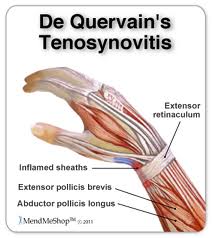
Persistent symptoms of pain along the thumb especially and including at the level of the wrist during texting can lead to a repetitive overuse injury. One such diagnosis is DeQuervain’s Tenosynovitis, also known as DeQuervain’s Syndrome.
Tenosynovitis is defined as the inflammation of the fluid-filled sheath that surrounds a tendon. DeQuervains’ Syndrome is a tenosynovitis of the sheath or tunnel that surrounds two tendons that control movement of the thumb.It is named after the Swiss surgeon Fritzde Quervain, who first identified it in 1895.
A simple test called Finkelstein’s test is used to diagnose DeQuervain’s Syndrome in people who have wrist/thumb pain. To perform the test, the physician grasps the hand with the fingers closed over the thumb in a fist and the wrist is bent towards the little finger. If sharp pain occurs along the top of forearm, about an inch below the wrist, DeQuervain’sSyndrome is likely.
Your physician will refer you for hand therapy. You will be fitted with a splint that supports your wrist and thumb up to your forearm as the tendons affected start as muscles in the forearm. Therapy may consist of gentle stretches, techniques to reduce edema, and anti-inflammatory regimen including modalities of ultrasound, electrical stimulation, and icing.
Vital to your therapy will be instruction in tendon protection techniques for your specific daily activities and symptom control techniques to carry over as part of your home program. As symptoms decrease, your therapist will gradually progress to strengthening as you return to your normal daily activities.
If symptoms persist, your doctor may do a corticosteroid injection. Surgery may be recommended if symptoms are severe or do not improve. The goal of surgery is to open the compartment to make more room for the irritated tendons. He would refer you back to hand therapy to assist in improving flexibility, reduce swelling and help with decreasing scar adhesions as the skin is close to the underlying tendons. You would be provided with a thorough home program.
It is recommended that you continue with the tendon protection techniques as a lifestyle to avoid reoccurence of symptoms. Texting has become a major form of communication in our daily lives. Be smart with use of your smart phone or handheld device.

